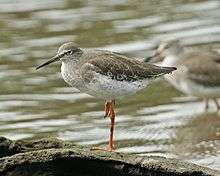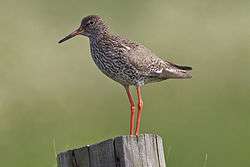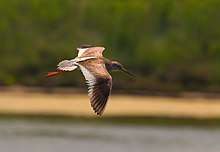Common redshank
The common redshank or simply redshank (Tringa totanus) is a Eurasian wader in the large family Scolopacidae. The genus name Tringa is the New Latin name given to the green sandpiper by Aldrovandus in 1599 based on Ancient Greek trungas, a thrush-sized, white-rumped, tail-bobbing wading bird mentioned by Aristotle. The specific totanus is from Tótano, the Italian name for this bird.[2]

| Common redshank | |
|---|---|
 | |
| Breeding plumage | |
| Scientific classification | |
| Kingdom: | Animalia |
| Phylum: | Chordata |
| Class: | Aves |
| Order: | Charadriiformes |
| Family: | Scolopacidae |
| Genus: | Tringa |
| Species: | T. totanus |
| Binomial name | |
| Tringa totanus | |
 | |
| Range of T. totanus Breeding Resident Passage Non-breeding | |
| Synonyms | |
| |
Description and systematics

Common redshanks in breeding plumage are a marbled brown color, slightly lighter below. In winter plumage they become somewhat lighter-toned and less patterned, being rather plain greyish-brown above and whitish below. They have red legs and a black-tipped red bill, and show white up the back and on the wings in flight.
The spotted redshank (T. erythropus), which breeds in the Arctic, has a longer bill and legs; it is almost entirely black in breeding plumage and very pale in winter. It is not a particularly close relative of the common redshank, but rather belongs to a high-latitude lineage of largish shanks. T. totanus on the other hand is closely related to the marsh sandpiper (T. stagnatilis), and closer still to the small wood sandpiper (T. glareola). The ancestors of the latter and the common redshank seem to have diverged around the Miocene-Pliocene boundary, about 5–6 million years ago. These three subarctic- to temperate-region species form a group of smallish shanks with have red or yellowish legs, and in breeding plumage are generally a subdued light brown above with some darker mottling, and have somewhat diffuse small brownish spots on the breast and neck.[3]
Subspecies
Several subspecies have been identified. These include:
- T. t. robusta - (Schiøler, 1919)[4]: found in Iceland and the Faroe Islands.
- T. t. ussuriensis - Buturlin, 1934[5]: found in southern Siberia, Mongolia and east Asia
- T. t. terrignotae - Meinertzhagen, R. & Meinertzhagen, A., 1926: found in southern Manchuria and eastern China
- T. t. craggi - Hale, 1971: found in north west China
- T. t. eurhina - (Oberholser, 1900)[6]: found in Tajikistan, north India and Tibet[7][8]
Ecology
The common redshank is a widespread breeding bird across temperate Eurasia. It is a migratory species, wintering on coasts around the Mediterranean, on the Atlantic coast of Europe from Ireland and Great Britain southwards, and in South Asia. They are uncommon vagrants outside these areas; on Palau in Micronesia for example, the species was recorded in the mid-1970s and in 2000.[9]
They are wary and noisy birds which will alert everything else with their loud piping call. Like most waders, they feed on small invertebrates. Redshanks will nest in any wetland, from damp meadows to saltmarsh, often at high densities.[10] They lay 3–5 eggs.
The common redshank is one of the species to which the Agreement on the Conservation of African-Eurasian Migratory Waterbirds (AEWA) applies.
It is widely distributed and quite plentiful in some regions, and thus not considered a threatened species by the IUCN.[11]
References
- BirdLife International (2013). "Tringa totanus". IUCN Red List of Threatened Species. 2013: e.T22693211A50404828. doi:10.2305/IUCN.UK.2013-2.RLTS.T22693211A50404828.en.
- Jobling, James A (2010). The Helm Dictionary of Scientific Bird Names. London: Christopher Helm. pp. 388, 390. ISBN 978-1-4081-2501-4.
- Pereira, Sérgio Luiz; Baker, Alan J. (2005). "Multiple Gene Evidence for Parallel Evolution and Retention of Ancestral Morphological States in the Shanks (Charadriiformes: Scolopacidae)". The Condor. 107 (3): 514–526. doi:10.1650/0010-5422(2005)107[0514:MGEFPE]2.0.CO;2.
- Schiøler, E.L. (1919). "Om den Islandske Redben (Totunus calidris robustus)". Dansk Ornitologisk Forenings (in Danish). XIII: 207–211.
- Buturlin, S.A. (1934). Полный определитель птиц СССР [Polnyi Opredelitel Ptitsy SSSR] [Complete keys to the birds of the USSR] (in Russian). I: 88.
- Oberholser, H.C. (1900). "Birds from Central Asia". Proceedings of the U.S. National Museum. XXII: 207–208.
- Gill, Frank; Donsker, David, eds. (2019). "Sandpipers, snipes, coursers". World Bird List Version 9.2. International Ornithologists' Union. Retrieved 26 June 2019.
- Hale, W.G. (1971). "A revision of the taxonomy of the Redshank Tringa totanus". Zoological Journal of the Linnean Society. 50 (3): 199–268. doi:10.1111/j.1096-3642.1971.tb00761.x.
- Wiles, Gary J.; Johnson, Nathan C.; de Cruz, Justine B.; Dutson, Guy; Camacho, Vicente A.; Kepler, Angela Kay; Vice, Daniel S.; Garrett, Kimball L.; Kessler, Curt C.; Pratt, H. Douglas (2004). "New and Noteworthy Bird Records for Micronesia, 1986–2003". Micronesica. 37 (1): 69–96. Archived from the original on 5 May 2009.
- Cadbury, C. J.; Green, R.; Allport, G. (1987). "Redshanks and other breeding waders of British saltmarshes". RSPB Conservation Review. 1: 37–40 – via https://www.researchgate.net/publication/299410567_Redshanks_and_other_breeding_waders_of_British_saltmarshes.
- "Species factsheet: Tringa totanus". www.birdlife.org. BirdLife International. 2008.
External links
| Wikimedia Commons has media related to Tringa totanus. |
| Wikispecies has information related to Tringa totanus |
- Chisholm, Hugh, ed. (1911). . Encyclopædia Britannica (11th ed.). Cambridge University Press.
- Redshank Images and documentation
- Ageing and sexing (PDF; 1.4 MB) by Javier Blasco-Zumeta & Gerd-Michael Heinze
- "Tringa totanus". Avibase.

- "Common redshank media". Internet Bird Collection.
- Common redshank photo gallery at VIREO (Drexel University)
- Interactive range map of Tringa totanus at IUCN Red List maps
- Audio recordings of Common redshank on Xeno-canto.
- Tringa totanus in the Flickr: Field Guide Birds of the World
- Common redshank media from ARKive

